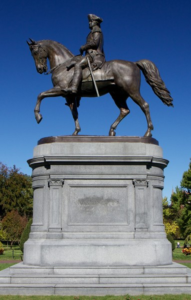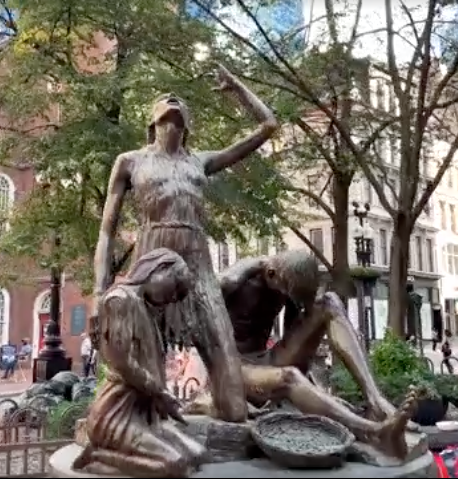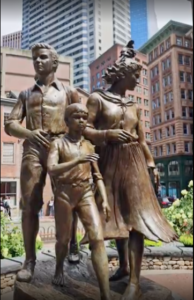The Young Man on Church Street
Making the Case for Sculptures of the Everyman
Photos and Story by Richard Frenkel
One day as I was driving from my home in Swampscott to go for a walk in Manchester Woods, I made the usual right from Cabot Street, Beverly, onto Church Street, and realized that the young man sitting on a low stone wall in the square there was in fact immortalized in bronze. I’d probably passed him many times before but never consciously realized he was a sculpture. This time I stopped and walked over.
 It turns out that he’s part of the Vietnam Veterans Memorial Plaza which has been around since 1981 but was redone in 2018. The selective service was located in an adjacent building and after young men would visit the draft board, they would wait outside, on a bench, for the bus to take them to the induction center in Boston where they would select their branch of service and from there be sent to basic training.
It turns out that he’s part of the Vietnam Veterans Memorial Plaza which has been around since 1981 but was redone in 2018. The selective service was located in an adjacent building and after young men would visit the draft board, they would wait outside, on a bench, for the bus to take them to the induction center in Boston where they would select their branch of service and from there be sent to basic training.
For me though, the sculpture is more universal. The slouched posture suggests the angst of leaving home and with it childhood. Of facing an unknown future. Of being on your own with virtually no weight in the world. For me personally that time was a combination of extreme loneliness and at the same time deep protective self love. The miracle is that this design was chosen, which suggests to me that I’m hardly alone in my feelings, veterans were deeply involved in the selection process.
There is a small sprinkling of such sculptures of ordinary people doing ordinary things around the Boston area. They stand (or sit) in sharp contrast to heroic sculptures.
Search Google for “Boston sculptures” and you’ll find 500 of George Washington on his horse, but not a single one of the two middle aged fellows, one sitting on a bench, the other standing casually, near the Holocaust Museum.

Public sculptures, even just the figurative ones, serve many purposes. The ancient Greeks perfected naturalistic sculptures of the human body, even if many of them were of the young and ideal. They glorified us humans. It’s safe to say that public sculptures of naked athletic young males are uncommon in the US. Although there are some, such as Gwen Marcus’ amazing “The Tempest” on the grounds of the Cape Cod Art Museum. Many sculptures, such as the one of George Washington, are commemorative of military men or victories, while others immortalize the famous of both sexes, although historically they’re mostly men.

More recent sculptures often deal with social issues, and these include more women. The Boston Irish Famine Memorial features two sculptures of a family, one starving in Ireland, the other well fed and healthy having migrated to Boston. Illustrative, obvious, but hard to identify with personally. My parents also came over as refugees. For me a sculpture of a 1954 Buick would have been a better “after” story.

Recently “The Embrace”, a memorial to Martin Luther and Coretta Scott King, was unveiled in Boston. This sculpture isn’t “figurative” since it only includes arms as identifiable body parts. For many, the prevalent emotion it evokes is confusion, something it has in common with many semi-figurative sculptures.
It’s interesting, and of course open to individual interpretation, and there’s nothing wrong with that. Indeed there’s nothing wrong with purely abstract sculpture. Every year I go to the “Flying Horse” Outdoor Sculpture Exhibit at Pingree School in Hamilton and revel in the skill and creativity and often humor of sculptures that run the gamut from figurative to purely abstract. I remember a sculpture of a young woman looking pensively out over the pond there. You had to approach her from her perfectly sculpted back, and it was quite a shock to see that, from the front, she was an empty shell facing the pond.
That said, I want to plead for more life sized sculptures of ordinary people doing ordinary things like the young man on Church Street. The Greeks glorified us humans, at least in the ideal. It is time to “glorify” the ordinary person doing ordinary things. After all, that is almost all of us. It is important to be reminded that life consists of a series of ordinary experiences which in the end, I am convinced, are what gives us “meaning”.
Also, during times when many suffer what has been called an epidemic of loneliness, the young man sitting on the wall and the bronze man on the park bench remind us that in fact we are not alone. There are others like us, and many more before us. Democracy calls for us to respect ourselves, the common people, who will never be famous. And finally, these sculptures connect us to the continuum of history. The young man on Church Street wears clothes I wore in 1970 and reminds us that on that very spot 50 years ago the Selective Service was drafting young men to wage a war from which over 50,000 of them would never return. Our young man on Church Street could well have been one of them, and I can not think of a more fitting, poignant, or ultimately glorious, memorial.

Well done, Richard. Your words resonate and empathize. As the great-great-granddaughter of Irish immigrants who did leave Ireland because of the famine, I appreciate the statues in Boston that honor them. Thank you for writing this.